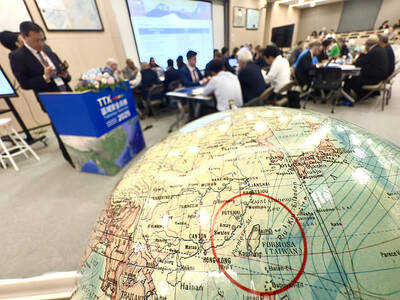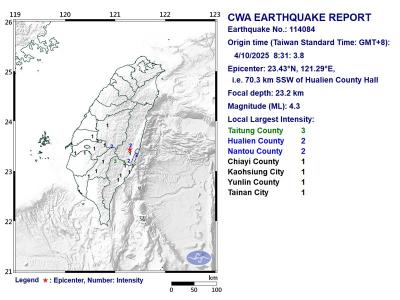The recent media spotlight on ducks contaminated with toxic chemicals from steel slag dumped at a site in Kaohsiung County has prompted the central government and local government agencies to step up checks and start investigations over other possibly polluted locations left behind by the county’s steel industry.
While these measures promise to clear up the problem, critics said the real culprits have yet to be caught, while the corporations behind the pollution haven’t been found, adding that there may be more polluted locations that haven’t been checked.
There is a problem with all ducks that were raised on a polluted farm in Daliao Township (大寮), Kaohsiung County, that was closed by the Environmental Protection Administration (EPA) on Nov. 7. EPA officials culled 9,000 ducks there on Wednesday, but critics said all ducks that were raised on the site prior to that were also contaminated.
Environmental groups led by Huang Huan-chang (黃煥彰), an environmental activist and the organizer of an environmental protection program at Tainan Community University who tipped off investigators about the polluted farm, said they had seen ducks on the farm since 2006.
Huang said he brought officials from the EPA to the farm on July 22, more than two weeks before operators said they began raising ducks.
After showing reporters picture evidence, Huang said that he “absolutely guarantees that the ducks have [been sold] on the marketplace” despite the farm operator’s denial.
However, the problem isn’t with the farm owners that have allegedly been sold chemical-tainted ducks on the market, Huang said, adding that it seems their denial that they knew the land was contaminated when they rented it from Uni-President Enterprises was likely to be true.
Instead, the problem is how to clean all the polluted land in Daliao, he said. Huang, who has long taken an interest in contaminated land, said another list of polluted locations would soon be released.
Land contamination comes from improper disposal of hazardous waste or in the duck farm’s case — the illegal dumping of steel furnace slag and foundry ash. These pollutants come from factories and plants that produce waste by the truckloads and then ask disposal companies to haul it away, often turning a blind eye in the process, said Chao Jui-kuang (晁瑞光), environmental and natural sciences manager at Tainan Community University.
Chao worked with Huang in investigating other locations contaminated by furnace slag.
EPA Environmental Health and Pollutant Management Director Wang Jiunn-iuan (王俊淵) said the reason there is so much contaminated land is mainly because of illegal dumping by the disposal companies before more effective management methods were introduced in 2001.
Although laws were already in place, they were not enforced, he said. Only when the management systems of hazardous waste disposal trucks were digitized in 2002 did illegal dumping begin to subside, he said. Currently, the EPA requires hazardous waste disposal trucks to be outfitted with Global Positioning Systems (GPS) to track their locations at all times. This has greatly reduced the amount of illegal dumping, Wang said.
However, while illegal dumping has been reduced, the bigger problem is that no one knew about Daliao’s contaminated duck farm — which is at the origin of the media storm about contaminated ducks — until after Huang learned about the contamination by chance.
“We only started to suspect that the duck farm was polluted after passing it on the way to conduct another pollution analysis,” Huang said.
The color of its soil and its surrounding vegetation all appeared to be polluted, he said.
Huang said that if he had not tipped the authorities off, it was unlikely the Daliao duck farm would have been investigated. The ducks were later found to have levels of copper, nickel, chromium, zinc, arsenic and lead that were two to 10 times the safety limit. They were also found to contain up to five times the recommended maximum level of dioxins — which the WHO states can cause impairment of immune, nervous and reproductive systems after long-term exposure.
EPA officials said there was not enough manpower and resources to investigate every single location for traces of illegal dumping. They said that currently, the EPA already knows of 175 contaminated locations nationwide, all of which were the result of illegal dumping before 2001. Of the 17 locations that pose an immediate threat to the public, 16 have already been closed and one is in the process of being closed, officials said.
Wang said the EPA relies on public complaints to find polluted land. He said the Daliao duck farm was located in an area that was sparsely populated and as a result, no one came forward before Huang.
However, faced with intense media pressure over contaminated land, he promised the EPA would, “develop a more complete plan for dealing with illegal dumping.”
The EPA will work with local authorities because “these problems usually fall under their jurisdiction,” Wang said.
The problem with the EPA’s reliance on public complaints is that most of the public lacks an understanding of how to spot signs of pollution, critics said.
As a result, it is very likely large areas of contaminated land will remain polluted for some time to come, Huang said.
Recent media attention would suggest that the issue of contaminated land has finally caught the attention of both the public and the EPA, Chao said.
However, if it weren’t for the Daliao ducks, the whole issue may have simply been buried, he said.

DEFENSE: The National Security Bureau promised to expand communication and intelligence cooperation with global partners and enhance its strategic analytical skills China has not only increased military exercises and “gray zone” tactics against Taiwan this year, but also continues to recruit military personnel for espionage, the National Security Bureau (NSB) said yesterday in a report to the Legislative Yuan. The bureau submitted the report ahead of NSB Director-General Tsai Ming-yen’s (蔡明彥) appearance before the Foreign and National Defense Committee today. Last year, the Chinese People’s Liberation Army (PLA) conducted “Joint Sword-2024A and B” military exercises targeting Taiwan and carried out 40 combat readiness patrols, the bureau said. In addition, Chinese military aircraft entered Taiwan’s airspace 3,070 times last year, up about

The Overseas Community Affairs Council (OCAC) yesterday announced a fundraising campaign to support survivors of the magnitude 7.7 earthquake that struck Myanmar on March 28, with two prayer events scheduled in Taipei and Taichung later this week. “While initial rescue operations have concluded [in Myanmar], many survivors are now facing increasingly difficult living conditions,” OCAC Minister Hsu Chia-ching (徐佳青) told a news conference in Taipei. The fundraising campaign, which runs through May 31, is focused on supporting the reconstruction of damaged overseas compatriot schools, assisting students from Myanmar in Taiwan, and providing essential items, such as drinking water, food and medical supplies,

STRICTER ENFORCEMENT: Taipei authorities warned against drunk cycling after a sharp rise in riding under the influence, urging greater public awareness of its illegality Taipei authorities have issued a public warning urging people not to ride bicycles after consuming alcohol, following a sharp rise in riding under the influence (DUI) cases involving bicycles. Five hundred and seven people were charged with DUI last year while riding YouBikes, personal bicycles, or other self-propelled two-wheelers — a fourfold increase from the previous year, data released by the Taipei Police Department’s Traffic Division showed. Of these, 33 cases were considered severe enough to be prosecuted under “offenses against public safety,” the data showed. Under the Road Traffic Management and Penalty Act (道路交通管理處罰條例), bicycles — including YouBikes and other

A magnitude 4.3 earthquake struck eastern Taiwan's Hualien County at 8:31am today, according to the Central Weather Administration (CWA). The epicenter of the temblor was located in Hualien County, about 70.3 kilometers south southwest of Hualien County Hall, at a depth of 23.2km, according to the administration. There were no immediate reports of damage resulting from the quake. The earthquake's intensity, which gauges the actual effect of a temblor, was highest in Taitung County, where it measured 3 on Taiwan's 7-tier intensity scale. The quake also measured an intensity of 2 in Hualien and Nantou counties, the CWA said.